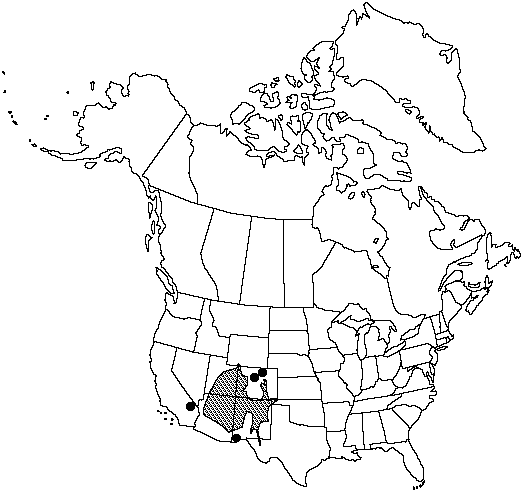Difference between revisions of "Pinus edulis"
in Wislizenus, Mem. Tour N. Mexico 88. 1848.
FNA>Volume Importer |
imported>Volume Importer |
||
| (5 intermediate revisions by 2 users not shown) | |||
| Line 1: | Line 1: | ||
{{Treatment/ID | {{Treatment/ID | ||
|accepted_name=Pinus edulis | |accepted_name=Pinus edulis | ||
| − | |accepted_authority=Engelmann | + | |accepted_authority=Engelmann |
|publications={{Treatment/Publication | |publications={{Treatment/Publication | ||
| − | |title=in Wislizenus,Mem. Tour N. Mexico | + | |title=in Wislizenus, Mem. Tour N. Mexico |
|place=88. 1848 | |place=88. 1848 | ||
|year=1848 | |year=1848 | ||
| Line 12: | Line 12: | ||
|name=Caryopitys edulis | |name=Caryopitys edulis | ||
|authority=(Engelmann) Small | |authority=(Engelmann) Small | ||
| + | |rank=species | ||
}} {{Treatment/ID/Synonym | }} {{Treatment/ID/Synonym | ||
|name=Pinus cembroides var. edulis | |name=Pinus cembroides var. edulis | ||
|authority=(Engelmann) Voss | |authority=(Engelmann) Voss | ||
| + | |rank=variety | ||
}} | }} | ||
|hierarchy=Pinaceae;Pinus;Pinus edulis | |hierarchy=Pinaceae;Pinus;Pinus edulis | ||
| Line 40: | Line 42: | ||
-->{{#Taxon: | -->{{#Taxon: | ||
name=Pinus edulis | name=Pinus edulis | ||
| − | + | |authority=Engelmann | |
| − | |authority=Engelmann | ||
|rank=species | |rank=species | ||
|parent rank=genus | |parent rank=genus | ||
| Line 51: | Line 52: | ||
|distribution=Ariz.;Calif.;Colo.;N.Mex.;Okla.;Tex.;Utah;Wyo.;Mexico in Chihuahua. | |distribution=Ariz.;Calif.;Colo.;N.Mex.;Okla.;Tex.;Utah;Wyo.;Mexico in Chihuahua. | ||
|reference=None | |reference=None | ||
| − | |publication title=in Wislizenus,Mem. Tour N. Mexico | + | |publication title=in Wislizenus, Mem. Tour N. Mexico |
|publication year=1848 | |publication year=1848 | ||
|special status= | |special status= | ||
| − | |source xml=https:// | + | |source xml=https://bitbucket.org/aafc-mbb/fna-data-curation/src/2e0870ddd59836b60bcf96646a41e87ea5a5943a/coarse_grained_fna_xml/V2/V2_351.xml |
|genus=Pinus | |genus=Pinus | ||
|species=Pinus edulis | |species=Pinus edulis | ||
Latest revision as of 20:22, 5 November 2020
Shrubs or trees to 21m; trunk to 0.6m diam., strongly tapering, erect; crown conic, rounded, dense. Bark red-brown, shallowly and irregularly furrowed, ridges scaly, rounded. Branches persistent to near trunk base; twigs pale red-brown to tan, rarely glaucous, aging gray-brown to gray, glabrous to papillose-puberulent. Buds ovoid to ellipsoid, red-brown, 0.5–1cm, resinous. Leaves (1–)2(–3) per fascicle, upcurved, persisting 4–6 years, 2–4cm × (0.9–)1–1.5mm, connivent, 2-sided (1-leaved fascicles with leaves 2-grooved, 3-leaved fascicles with leaves 3-sided), blue-green, all surfaces marked with pale stomatal bands, particularly the adaxial, margins entire or finely serrulate, apex narrowly acute to subulate; sheath 0.5–0.7cm, scales soon recurved, forming rosette, shed early. Pollen cones ellipsoid, ca. 7mm, yellowish to red-brown. Seed cones maturing in 2 years, shedding seeds and falling soon thereafter, spreading, symmetric, ovoid before opening, depressed-ovoid to nearly globose when open, ca. (3.5–)4(–5)cm, pale yellow- to pale red-brown, resinous, nearly sessile to short-stalked; apophyses thickened, raised, angulate; umbo subcentral, slightly raised or depressed, truncate or umbilicate. Seeds mostly ellipsoid to obovoid; body 10–15mm, brown, wingless. 2n =24.
Habitat: Dry mountain slopes, mesas, plateaus, and pinyon-juniper woodland
Elevation: 1500–2100(–2700)m
Distribution

Ariz., Calif., Colo., N.Mex., Okla., Tex., Utah, Wyo., Mexico in Chihuahua.
Discussion
Pinus edulis var. fallax Little (P. californiarum subsp. fallax (Little) D.K.Bailey) appears to combine features of P. edulis and P. monophylla. More study is needed.
Seeds of Pinus edulis, the commonest southwestern United States pinyon, are much eaten and traded by Native Americans.
Pinyon (Pinus edulis) is the state tree of New Mexico.
Selected References
None.